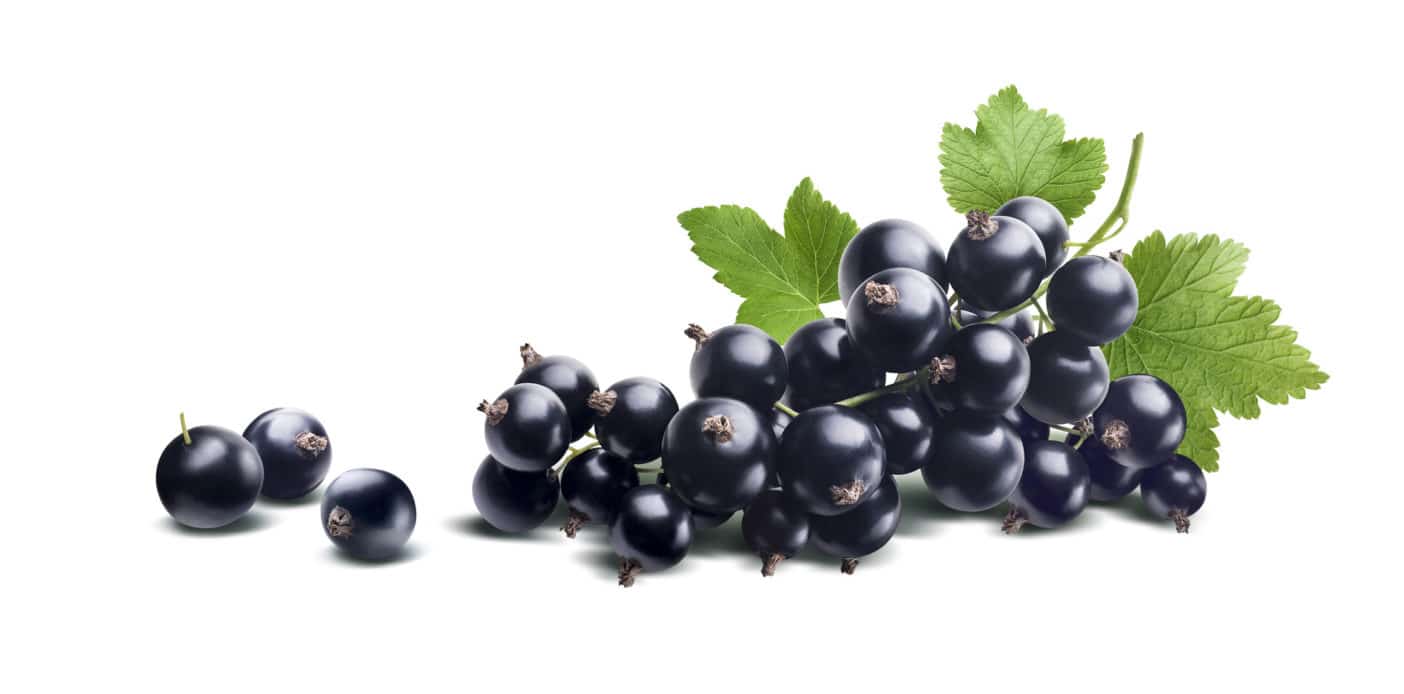Blackcurrant seed oil

The blackcurrant (Ribes nigra) belongs to the gooseberry family. Its fruits are rich in vitamins and are very popular in the kitchen, for example for summer fruit tarts, desserts and juices. The plant was originally native to Asian forest areas, but is now cultivated throughout Central Europe. The shrub, which can grow up to two metres tall, is an integral part of countless gardens in this country. Black berries, which are around one centimetre in diameter, grow in grape-like clusters and can be harvested from the end of June. As they are often ripe on St John’s Day (24 June), they were given the name “Johannisbeere” in German. Blackcurrant seed oil is produced by cold pressing or CO2 extraction from the seeds of the berries. It has a fruity, tart aroma and a beautiful yellow to slightly greenish colour. The flavour is pleasantly nutty.
The ingredients of blackcurrant seed oil
Blackcurrant seed oil is one of the most valuable seed oils of all, which is mainly due to the composition of the fatty acids. The proportion of unsaturated fatty acids is around 90 per cent. The oil not only contains plenty of alpha- and gamma-linolenic acid, but also the rare, 4-unsaturated stearidonic acid, which has only been sufficiently researched in recent years. It is considered to be extremely anti-inflammatory. The two linolenic acids are also characterised by their highly effective stabilising function for the barrier layer of our skin. They therefore maintain the skin’s own moisture, which is particularly beneficial for mature and dry skin. Incidentally, the proportion of alpha- and gamma-linolenic acid in this oil is around three times higher than in black cumin oil.
Blackcurrant seed oil is also rich in vitamin E and cell-protecting flavonoids.
Blackcurrant seed oil in herbal medicine
Among other things, blackcurrant seed oil is recommended as an adjuvant aftercare for cancer therapies, as the gamma-linolenic acid it contains is not only an extremely effective free radical scavenger, but also has a protective function against carcinogenic substances. Gamma-linolenic acid is also able to sustainably correct an abnormal fat metabolism (e.g. in the case of obesity). As a dietary supplement, the oil has a positive effect on the cardiovascular system and lipid metabolism.
The effect of blackcurrant actives in cosmetics
Blackcurrant seed oil is generally very well tolerated and extremely mild. Thanks to its polyunsaturated fatty acids, it has a cell-regenerating and cell-protecting effect, slows down the skin ageing process and stimulates the skin’s metabolism. Due to these properties, blackcurrant seed oil is often used in high-quality facial oils and anti-ageing products, for example. But that’s not all. Thanks to its high stearidonic acid content, it is also excellent for blemished skin, skin prone to spots and acne and inflammatory skin conditions. Even particularly sensitive skin is effectively soothed by the anti-inflammatory properties of blackcurrant seed oil. Blackcurrant seed oil can be just as helpful for skin irritations as it is for eczema. The bioactive substances (flavonoids) it also contains also help to improve resistance to allergies or infections.
As the oil has a naturally low oxidative stability, it works best in combination with other high-quality oils, such as jojoba or marula oil. It is also frequently used as a healing component in products containing shea butter.
Profile of blackcurrant seed oil
INCI: Ribes Nigrum (Black Currant) Seed Oil
CAS number: 97676-19-2
Composition: Linoleic acid (up to a maximum of 54.0 per cent), alpha-linolenic acid (8.0 to 18.0 per cent), gamma-linolenic acid (13.0 to 16.0 per cent), stearidonic acid (2.0 to 4.0 per cent)
Iodine value: 160 to 175
Usual use concentration: 1.0 to 5.0 per cent, in oil mixtures 10.0 to a maximum of 15.0 per cent
Spreading property: slow
Areas of application: for dry, mature, sensitive and blemished skin
Profile of blackcurrant leaf extract
INCI: Ribes Nigrum (Black Currant) Leaf Extract
Definition: Extract from the leaves of blackcurrant
Effect: helpful for dry and demanding skin
Profile of blackcurrant fruit extract
INCI: Ribes Nigrum (Black Currant) Fruit Extract
CAS number: 68606-81-5
EINECS number: 271-749-0
Properties: red-brown powder
We like to work with these active ingredients from blackcurrant seed oil:
| Name | Company Name | INCI Name | Remarks |
|---|---|---|---|
| Actipone Black Currant GW | Symrise | Aqua , Glycerin , Ribes Nigrum (Black Currant) Juice | |
| Refined Blackcurrant Seed Oil - BCE1024 | Biocosmethic | Ribes Nigrum (Black Currant) Seed Oil | |
| Seboxyl | Solabia Group | Glycerin , Ribes Nigrum (Black Currant) Leaf Extract , Rubus Idaeus (Raspberry) Leaf Extract | |
| BSB - Black Current Seed Butter | DKSH | Ribes Nigrum (Black Currant) Seed Oil , Hydrogenated Vegetable Oil | |
| BSB - Blackcurrant Seed Butter | EFP Biotek | Ribes Nigrum (Black Currant) Seed Oil , Hydrogenated Vegetable Oil | |
| Black Currant Buds Absolute | Robertet Flavors | Ribes Nigrum (Black Currant) Bud Extract | |
| Blackcurrent Seed Oil | Laboratoires Prod'Hyg | Ribes Nigrum (Black Currant) Seed Oil | |
| EPICA | Greentech | Alcohol , Aqua , Pinus Sylvestris Bark Extract , Ribes Nigrum (Black Currant) Leaf Extract | |
| PhytoCide Black Currant Powder | Active Micro Technologies LLC | Ribes Nigrum (Black Currant) Fruit Extract | |
| Black Currant (Seed) Oil | SanaBio GmbH | Ribes Nigrum (Black Currant) Seed Oil | |
| EFADUO | ACTYLIS | Ribes Nigrum (Black Currant) Seed Oil , Helianthus Annuus (Sunflower) Seed Oil , Rosmarinus Officinalis (Rosemary) Leaf Extract | |
| CVB - Chlorella Butter | DKSH | Chlorella Vulgaris Powder , Ribes Nigrum (Black Currant) Seed Oil , Olea Europaea (Olive) Fruit Oil , Hydrogenated Vegetable Oil | |
| CVB - Chlorella Butter | EFP Biotek | Chlorella Vulgaris Powder , Ribes Nigrum (Black Currant) Seed Oil , Olea Europaea (Olive) Fruit Oil , Hydrogenated Vegetable Oil | |
| Activoil™ Spotless ZRO | Innovacos | Ribes Nigrum (Black Currant) Seed Oil , Octyldodecanol , Octyldodecyl Oleate , Octyldodecyl Stearoyl Stearate , Paeonia Suffruticosa Root Extract , Rosmarinus Officinalis (Rosemary) Leaf Extract | |
| OceanDerMX Restore & Protect | Gfn-Selco | Aqua , Sarcothalia Circumcincta , Kousou Ekisu , Camellia Sinensis Leaf , Cyathea Medullaris Leaf Extract , Ribes Nigrum (Black Currant) Fruit Extract , Pentylene Glycol | |
| Activoil™ Spotless ZRO | DKSH | Rosmarinus Officinalis (Rosemary) Leaf Extract , Ribes Nigrum (Black Currant) Seed Oil , Paeonia Suffruticosa Root Extract , Octyldodecyl Stearoyl Stearate , Octyldodecyl Oleate , Octyldodecanol | |
| DEFENSIL®-PLUS | Rahn AG | Octyldodecanol , Ribes Nigrum (Black Currant) Seed Oil , Helianthus Annuus (Sunflower) Seed Oil Unsaponifiables , Cardiospermum Halicacabum Flower/Leaf/Vine Extract , Tocopherol , Helianthus Annuus (Sunflower) Seed Oil , Rosmarinus Officinalis (Rosemary) Leaf Extract | |
| BergaCare AquaLipids Cassis BR | Berg + Schmidt GmbH & Co. KG | Aqua , Glycerin , Cetyl Palmitate , Ribes Nigrum (Black Currant) Seed Oil , Rosa Moschata Seed Oil , Pentylene Glycol , Glyceryl Behenate , Hydrogenated Vegetable Oil , Sodium Stearoyl Glutamate , Tocopherol , Helianthus Annuus (Sunflower) Seed Oil | |
| EPICA Organic | Greentech | Aqua, Propanediol, Pinus Sylvestris Bark Extract, Ribes Nigrum (Black Currant) Leaf Extract |
Integrate blackcurrant seed oil into high-quality formulations
Thanks to its properties and ingredients, the oil is suitable for dry and mature skin as well as for impure and highly sensitive skin. It is very mild and generally well tolerated. Cosmacon will be happy to support you in the realisation of high-quality formulations with blackcurrant seed oil. Just get in touch with us.
Literature:
Magnavacca A, Piazza S, Cammisa A, Fumagalli M, Martinelli G, Giavarini F, Sangiovanni E, Dell’Agli M.Molecules. 2021 May 20;26(10):3044
Luzak B, Boncler M, Rywaniak J, Dudzinska D, Rozalski M, Krajewska U, Balcerczak E, Podsedek A, Redzynia M, Watala C.J Physiol Biochem. 2014 Dec;70(4):1007-19
Ziemlewska A, Zagórska-Dziok M, Nizioł-Łukaszewska Z.Sci Rep. 2021 Feb 5;11(1):3240
